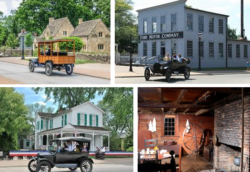


Greenfield Village houses a collection of historic buildings and faithful reproductions that has become a model for outdoor village museums in the United States. The village encompasses 80 acres in Dearborn Michigan, near Henry Ford’s original family homesite.
The automobile magnate was an avid collector, an avocation common among the American elite during the early 20th century. Uncommon though was the type of objects that struck Ford’s fancy. Rather than art or sculpture, Ford was drawn to objects that represented American ingenuity and progress. This collection grew to include everyday objects, machinery, and even buildings that would become the basis for the development of a museum and historical village.
Greenfield Village’s origin story can be traced to 1919, when a road construction project threatened Henry Ford’s childhood home. Rather than see his birthplace demolished, Ford relocated the house and embarked on a project to restore the home to its appearance at the time of his mother’s death in 1876. Ford personally attended to every detail of the restoration and dedicated the project to the memory of his mother, whom he credited with setting him upon the path towards his future successes.

Not long thereafter, Ford began collecting additional structures to be relocated to the site. Buildings vary in type and style, some represent rural and farm life, others demonstrate early American civic architecture, while still others simply honor people of importance in Ford’s life. Greenfield Village now houses some 100 structures organized into seven districts: Model T, Main Street, Edison at Work, Railroad Junction, Liberty Craftworks, Working Farms, and Porches and Parlors.
Buildings of note include Orville and Wilbur Wright’s original bicycle shop storefront, Thomas Edison’s laboratory, and Noah Webster’s home. Some of the oldest structures include the Cotswold cottage, stable, and forge, which represent the Village’s only imported structures coming from England, and constructed in the early 1600’s. The Farris Windmill is said to be the oldest windmill in the United States, relocated from Massachusetts with an original construction date of 1650. Several buildings are recreations that have been built to exhibit specific machinery or allow handicraft demonstrations, favorites among those include a pottery studio and glassblowing workshop.
Greenfield Village is open year-round, seven days a week from 9:30 am until 5 pm. For special events and more information visit www.thehenryford.org.
(Greenfield Village is also included on this month’s MAF Architecture Road Trip; click here to read the article).